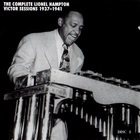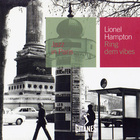Lionel Hampton

- Meta styles:
- Big Band/Swing, Early R&B, Jazz Instrument, New Orleans/Classic Jazz
- Styles:
- Big Band, Early Jazz, Mainstream Jazz, Swing, Vibraphone/Marimba Jazz
Lionel Leo Hampton (1908?2002), was a U.S. bandleader, jazz percussionist, and vibraphonist. Hampton was born on 20th April 1908 in Louisville, Kentucky, but moved to Chicago as a child, where he began his career as a drummer. He relocated to Los Angeles to play drums in Les Hite's band. They soon became the house band for Frank Sebastian's New Cotton Club, a popular L.A. jazz club. During a 1930 recording date in the NBC studios in L.A., Louis Armstrong discovered a vibraphone. He asked Hampton if he could play it.
Hampton was born on 20th April 1908 in Louisville, Kentucky, but moved to Chicago as a child, where he began his career as a drummer. He relocated to Los Angeles to play drums in Les Hite's band. They soon became the house band for Frank Sebastian's New Cotton Club, a popular L.A. jazz club.
During a 1930 recording date in the NBC studios in L.A., Louis Armstrong discovered a vibraphone. He asked Hampton if he could play it. Hampton, who knew how to play the xylophone, tried it and they agreed to record a few records with Hamp on vibes. Hampton is credited with popularizing the vibraphone as a jazz instrument.
In the mid-1930s, the Benny Goodman Orchestra came to Los Angeles to play the Palomar Ballroom. John Hammond brought Goodman to see Hampton play. Goodman asked Hampton to move to New York City and join Goodman, Teddy Wilson, and Gene Krupa who'd already formed a Benny Goodman Trio within the large band - to expand into the Benny Goodman Quartet. The Trio and Quartet were among the first racially integrated bands to record and play before wide audiences; they were just as well received at Goodman's famous 1938 Carnegie Hall concert as was the full Goodman band.
While Hampton worked for Goodman in New York, he recorded with several different small groups known as the Lionel Hampton Orchestra as well as assorted small groups within the Goodman band. In the early 40s he left the Goodman organization to form his own touring band.
Hampton's band fostered the talents of Illinois Jacquet, Dexter Gordon, Ernie Royal, Jack McVea, Charlie Mingus, Monk Montgomery, Wes Montgomery, Quincy Jones, Benny Golson, Fats Navarro, Kenny Dorham, Clifford Brown, Dinah Washington, Betty Carter, Joe Williams, Arnett Cobb, Earl Bostic, and John Colianni among many others.
Hampton's recording of "Flying Home" (1939) with the famous honking tenor sax solo by Jacquet, later refined and expanded by Cobb (1946), is considered by some to be the first rock and roll record. He was known for his tireless energy and his skill on the vibes, drums, and lightning speed two-fingered piano. The bars on the vibraphone are laid out like the piano; Hampton played both instruments the same way.
Beginning in the mid-1980s, Hampton and his band started playing at the University of Idaho's jazz concert, which in 1985 was renamed the Lionel Hampton Jazz Festival. In 1987 the University's music college was renamed the Lionel Hampton School of Music, the first and only university music college to be named after a jazz musician.
Lionel Hampton died of cardiac arrest at Mount Sinai Medical Center in New York on 31st August 2002. He was buried in the Woodlawn Cemetery, Bronx, New York.
- Sort by

The Complete Lionel Hampton Victor Sessions 1937-1941 CD5
- Year:
- 2007
- Tracks:
- 20
- Bitrate:
- 320 kbps

The Complete Lionel Hampton Victor Sessions 1937-1941 CD4
- Year:
- 2007
- Tracks:
- 23
- Bitrate:
- 320 kbps

The Complete Lionel Hampton Victor Sessions 1937-1941 CD3
- Year:
- 2007
- Tracks:
- 24
- Bitrate:
- 320 kbps

The Complete Lionel Hampton Victor Sessions 1937-1941 CD2
- Year:
- 2007
- Tracks:
- 17
- Bitrate:
- 320 kbps

The Complete Lionel Hampton Victor Sessions 1937-1941 CD1
- Year:
- 2007
- Tracks:
- 23
- Bitrate:
- 320 kbps

Vibe Boogie CD4
- Year:
- 2005
- Tracks:
- 11
- Bitrate:
- 320 kbps

Vibe Boogie CD3
- Year:
- 2005
- Tracks:
- 18
- Bitrate:
- 320 kbps

Vibe Boogie CD2
- Year:
- 2005
- Tracks:
- 18
- Bitrate:
- 320 kbps

Vibe Boogie CD1
- Year:
- 2005
- Tracks:
- 23
- Bitrate:
- 320 kbps

Ring Dem Vibes
- Year:
- 2002
- Tracks:
- 7
- Bitrate:
- 320 kbps
 Benny Goodman
Benny Goodman  Duke Ellington
Duke Ellington  Fletcher Henderson
Fletcher Henderson  Bobby Hutcherson
Bobby Hutcherson  Count Basie
Count Basie  Erskine Hawkins
Erskine Hawkins  Illinois Jacquet
Illinois Jacquet  Jay McShann
Jay McShann  Johnny Lytle
Johnny Lytle  Johnny Otis
Johnny Otis  Lucky Millinder
Lucky Millinder  Milt Jackson
Milt Jackson  Red Norvo
Red Norvo  Rob McConnell
Rob McConnell  Chick Webb
Chick Webb